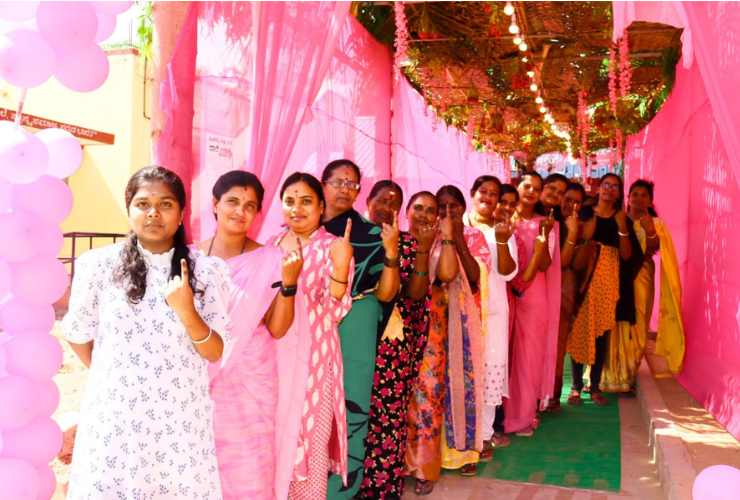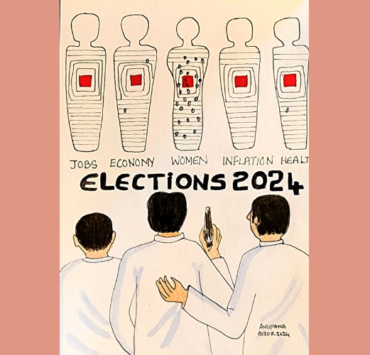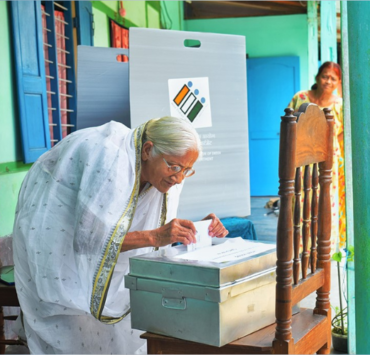
By C G Manjula

The final voter turnout in the 14 parliamentary constituencies included in the first phase of polling in Karnataka on April 26 was 69.59%. Women voters outnumbered men in five of the 14 constituencies, according to the revised data shared by the Election Commission (EC) last week.
The press note published on the EC website on April 30, after opposition leaders questioned the delay in providing the final data, put female voter turnout in the state at 69.65%, while the male voter turnout was pegged at 69.48%. Despite the fact that marginally more men voted during the first two phases of polling on April 19 and 26 across 34 states and union territories (66.22% and 66.99% respectively), compared to women (66.07% and 66.42%), Karnataka registered a little increase in female voter turnout.
It is interesting to note that although Bengaluru recorded the lowest turnout overall in the state, more women than men voted in all the four constituencies in the city. According to the EC, in Bangalore Central, Bangalore North, Bangalore Rural and Bangalore South, the female voter turnout was 54.87%, 55.45%, 69.03% and 54.17% respectively, as against the male voter turnout of 53.31%, 53.52%, 67.60% and 52.24% respectively in the same constituencies. Another constituency where more women voted (78.19%) compared to men (76.90%) is Dakshina Kannada.
On the whole, the percentage of women voters was higher in rural areas than in urban constituencies. It has been reported that the female turnout at polling booths was above 80% in all the Assembly constituencies of Tumkur (except Tumkur city), Mandya, Chamarajanagara, Bengaluru Rural, Chickballapur and Kolar. In the Mysuru Parliamentary constituency, the three Assembly constituencies within the city – Krishnaraja, Chamaraja and Narasimharaja – recorded women voting at 59%, 60% and 64% respectively, while all the remaining constituencies recorded female voter turnouts above 70%.
The Melkote Assembly constituency recorded the highest number of women voting at 86.5%. In Hoskote it was 85.3%. Several constituencies – such as Magadi, Srirangapatna, Nelamangala, Ramanagara, Kanakapura and Channapatna – are among those that recorded over 83% female voters.
In the Bengaluru Rural Parliamentary constituency, the urban Assembly segments of Rajarajeshwarinagar, Bengaluru South and Anekal recorded less than 61% of women voting, while rural segments saw a higher turnout of women: over 83%.
The current upward trend of more and more women exercising their franchise reflects a continuation of the rise in female turnout over the years.
However, Mansoor Ali Khan, the Indian National Congress (INC) candidate in Bengaluru Central, attributed the pattern during the recent phase of voting in Karnataka to the success of the present Congress government’s guarantee schemes. “The higher percentage of women voting in rural areas is a clear indication of the success of our guarantee schemes,” he claimed.
Many people echo this view. It is being said the five guarantee schemes implemented by the Karnataka government since it was formed in mid-2023 have somewhat reduced the financial burden on several households in the state during this time of high inflation.
About 1.1 crore women whose households are categorised as Below Poverty Line (BPL) are direct beneficiaries of the government’s ‘Gruha Lakshmi’ Scheme, which provides monthly financial assistance of Rs 2000 to woman-headed BPL families. The free travel scheme, ‘Shakti’, which enables women to use ordinary public transport without buying tickets, has enthused women and enabled poor working class women to use the money saved for other family expenses. In addition, many families have benefited from the ‘Gruha Jyothi’ (free electricity up to 200 units), ‘Anna Bhagya’ (free foodgrains) and ‘Yuva Nidhi’ (financial support to educated unemployed youth) schemes.
Out of the 28 Lok Sabha constituencies in Karnataka, women voters currently outnumber men in as many as 17. Over the years it has been observed that women voters have been increasingly exercising their franchise independently, without submitting to the authority of male members of the family. Although caste and community considerations also matter in making political choices, several ground reports suggest that the benefits that have accrued from the Congress government’s guarantees may well influence women voters in the state this time.

In an effort to counter this possible trend, the Bharatiya Janata Party (BJP) is also pushing the counter-narrative of ‘Modi Ki Guarantee’ through ‘Viksit Bharat’ (Developed India), ‘Ek Bharat, Shrestha Bharat’ (One India, Great India), and so on. The four pillars of ‘Viksit Bharat’ are youth, the poor, women and farmers. Accordingly, the guarantee is reportedly for the development of youth, empowerment of women and welfare of farmers and the poor – as members of marginalised and vulnerable sections of society who have been ignored for decades.
It has been said that women voted for the BJP in large numbers during the 2019 general elections. Political parties have evidently realised that they can no longer ignore women voters. It is important to note that parties are not so liberal in giving tickets to women to contest elections. In the last two phases of the Lok Sabha elections, held on April 19 and April 26, the percentage of female candidates was just 8%.
However, parties have been devising strategies aimed at wooing female voters. For example, the manifestos of both the BJP and the Congress include specific promises to women voters. While the BJP has promised to expand the Lakhpati Didi scheme to enable women to earn an annual income of Rs 1 lakh, the Congress has promised the Mahalakshmi scheme to provide Rs 1 lakh per year to every poor Indian family as an unconditional cash transfer. There are many other such promises from the two major parties, as well as others, targeting women voters.
In Karnataka, of the total of 5.42 crore voters (as on March 16), 2.7 crore – nearly 50% – are women. According to Manoj Kumar Meena, Chief Electoral Officer for Karnataka, there has been a constant improvement in the gender ratio, which has risen from 958 (per 1,000 males) during the 2013 Assembly elections to 960 during the 2014 Lok Sabha elections, 972 during the 2018 Assembly elections, 976 during the 2019 Lok Sabha elections, and 986 during the 2023 Assembly elections to 997 this year. The number of women voters in the state has gone up from 55.13 lakhs in 1962 to 2.7 crores this year.
It was during the 1984 Lok Sabha elections that a separate category identified as ‘women voters’ came into existence. Those general elections were held when there was a sympathy wave sweeping across the country after the assassination of Indira Gandhi. This made a large number of women come out of their houses and stand in queues at polling booths to vote. The polls ended in a landslide victory for the Congress. From a low 48 percent in 1971, the female voter turnout rose to nearly 60 per cent in 1984.
Women voting in Karnataka’s 28 Parliamentary constituencies during the 16th Lok Sabha elections in 2014 made up 65.81% of the total. In the coastal district of Dakshina Kannada, women’s voting rate was actually higher than men’s: 77.39% compared to 76.97%. However, even at that time, the BJP’s Shobha Karandlaje was the only female Member of Parliament among the state’s 28 MPs from Karnataka.
The Election Commission had then said that the number of women who had voted was the highest in the country in any parliamentary election. As many as 16 states/union territories had recorded high turnouts of female voters. The EC had attributed the jump in women’s turnout during the 2014 general election to its own focused initiatives under the Systematic Voter Education and Electoral Participation (SVEEP) programme.
The increase in the number of female voters is a positive trend. However, the apparent, growing awareness among women about the importance of voting should be utilised to lobby for gender sensitive policies and programmes aimed at empowering women and improving their lives. That is what will bring about women-centric and women-led development, with women seen as agents of positive change and not just as beneficiaries of welfare programmes.
The question is: will women become a vote bank that can lobby for their own interests? It is true that women are not a homogeneous group; they belong to different classes, castes, religions, ethnicities and regions, with different needs and concerns. However, they also have many common concerns and demands. Women have to become a vote bank of their own if they are to play a decisive part in electoral victory or defeat.
Some analysts believe that women voters contributed to the Congress victory in the 2023 Karnataka Assembly elections. Tara Krishnaswamy, political commentator and co-founder of Political Shakti, says women voters look for delivery of promises. According to her, women had seen the action taken during the state government in place from 2013 to 2018, when Siddaramaiah was Chief Minister and the ‘Anna Bhagya’ (free rice) scheme was launched. But that scheme was later modified and reduced by the BJP government that took over with Basavaraj Bommai as CM. The earlier government had also launched the Indira Canteens but these outlets providing affordable food for the urban poor were neglected by the BJP government that followed.
The message is clear from women who have been coming forward in large numbers to vote. They want their voices to be heard in the public sphere. No party can safely ignore the continued rise in the number of women voters. It should become unavoidable and inevitable for politicians to respond to the demands of women.
However, women should not just remain and be seen only as voters. They should get more opportunities to become political leaders. The representation of women in the outgoing 17th Lok Sabha is just 14%. This is shameful for a country that has been described of late as the ‘Mother of Democracy’.
The Constitution (128th Amendment) Bill, 2023 – better known as the Women’s Reservation Bill and now enacted as the Constitution (106th Amendment) Act – was passed in both houses of Parliament almost unanimously in September 2023. It mandates that women must occupy at least 33 per cent of seats in state legislative assemblies as well as in parliament. However, the new legislation is unlikely to come into force for several years. So it is up to all those who supported the passage of the law to ensure that its aims are progressively met even before that.
C G Manjula is a senior journalist and writer, and the former Associate Editor, Prajavani.




